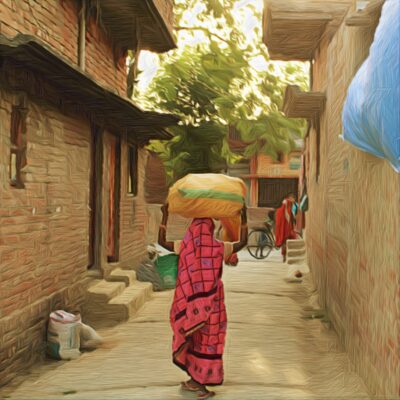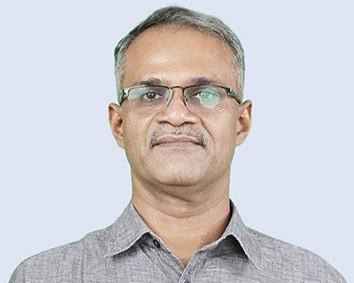In June 2023, we participated in the FAS-PARI survey of two villages of Uttar Pradesh, villages surveyed earlier in 2005. Drawing on this experience, and following a Focus Group Discussion, we prepared this note that discusses salient features of women’s work, especially of Dalit women workers in the two villages.
Dalit households comprise a majority of the population in Mahatwar village in Ballia district of eastern Uttar Pradesh, and Dalit women workers constitute the core of the agricultural work force. Dalit women are engaged in agricultural operations; the participation of women from other castes as agricultural labourers is almost negligible. At the same time, the demand for labour in agriculture has declined on account of mechanisation, and the actual days of employment available to Dalit women in the village is very low, not more than a month during the kharif season.
Wheat, paddy and mustard are the major crops grown in Mahatwar, and Dalit women are engaged in specific agricultural operations in these crops. Transplanting is the most important operation during the paddy season (kharif). Women also engage in weeding and harvesting. Transplanting paddy is and has been a woman’s task in many parts of India. Wages for transplanting in Mahatwar were low and often involved discriminatory practices. Let us illustrate.
Transplanting consists of two stages. The first is the planting of seedlings in a field, followed by the transplanting of seedlings after they have grown. For the first replanting of seedlings, the payment was 1 kg of rice and one rupee for replanting one bojha (24 seedlings). Usually, the cash equivalent of 1 kg of grain was paid. When converting kind to cash, the employer would often lower the wage by citing a price for grain that was lower than the current market price (for example, offering Rs. 20 when the market price was Rs 25-26). In a day, a group of eight women could replant 55 bojhas. They would thus be paid Rs. 55 per head, and the cash equivalent of 55 kg of rice, which amounted to around Rs. 144 per woman per day. The daily wage rate for men was Rs 290 when we visited the village, and the NREGS wage was Rs 202. Some women told us that some employers reduced wages further by undercounting the number of bojhas planted.
For the second stage of transplanting, wages were piece-rated (Rs. 2000 per bigha where 1.6 bigha equals one acre), irrespective of the number of women involved in the task. The earnings for a woman here depended on the number of women in a group. Some, but not all, employers gave them a meal, or biscuits and tea, in addition to the wages. The food was served in plastic plates because of their Dalit caste identity.
An important feature of women’s agricultural work in Mahatwar village is that women usually work in women-only groups. There is a woman group leader who assembles women whenever there is demand for work and takes them to the field. The group leader is not paid extra wages or other incentives. Likewise, for paddy and wheat harvesting also, women either go in groups or with their families.
There has been no change in wages since before the onset of the Covid-19 pandemic in 2020.
In the second village, Harevli in Bijnor district of western Uttar Pradesh, the cropping pattern was more complex than in Mahatwar. Here the major crops were sugarcane, wheat and paddy. Women belonging to two caste groups — Dhivar (included now in Other Backward Classes) and Dalits (Chamars and Valmikis) — were engaged in agriculture as labourers. In addition to labouring out in the fields of upper caste Tyagi farmers, women also provided family labour on their own miniscule landholdings.
Women in Harevli were engaged in sowing, weeding and harvesting of sugarcane and wheat; and transplanting, weeding and harvesting of paddy. The wages for these operations were largely piece-rated with few exceptions. For sugarcane harvesting the piece-rate wages were around Rs. 30 per quintal, and for wheat harvesting the wages were paid in kind at the rate of 40 kg of wheat per bigha (1 bigha = 0.2 acre). In addition to these piece-rated contracts, women were hired as daily wage labourers in specific crop operations such as manual weeding and sowing in sugarcane. The daily wage rate for women for these operations ranged from Rs. 200-300, lower than the daily wage rate for men, which was around Rs. 400.
In Harevli, women generally worked on the fields as part of a family group. A family may take the contract to harvest sugarcane or wheat on a certain plot. Women, old and young, children and men work together at this task. The payment is to the family. It is difficult to measure the share of earnings of women, and even more difficult to assess the degree of control women have over the earnings received.
While women were free to work for any employer in Mahatwar, in Harevli a very specific phenomenon was noted. Here tenancy was used as a way to secure labour and tie the tenant to the landowner. If a Dalit household had leased in land, they were called to provide labour to the Tyagi farmer when required (and paid at the going wage). This can be viewed as a ‘beck and call’ relationship between members of tenant households and the landowner. Women and children of the tenant family worked alongside men when called by the landowner to work on his fields.
In both the study villages, animal rearing was an important part of Dalit women’s responsibilities. Women participated in all aspects of animal care, be it collecting dung, cutting grass for fodder or selling milk and arranging for veterinary care. Women spent at least two hours a day on such tasks though the activities were spread out over the day. Labour involved in animal rearing is not only physically demanding but also gender-specific. Women are the primary caretakers of household animals, reflecting a clear gender division of labour.
Outside of agriculture and animal rearing, employment opportunities were virtually non-existent for women in the two villages. There was practically no non-agricultural employment other than MGNREGA available to women. On account of social and cultural norms, most women did not seek work outside the village.
In closing, Dalit women are central to the agricultural work force in Uttar Pradesh, as in many other parts of India. At the same time, the days of employment available in agriculture were very low, and options outside agriculture were limited, as women were restricted to work within the village. Women’s wages were lower than men’s, had remained unchanged for the last three years, and often varied across employers on account of personal practices. From the arduous and often unfair conditions of agricultural work to the all-consuming and gendered responsibilities of animal care, these women’s lives are shaped by their labour. The absence of alternative employment opportunities constrains their economic mobility and social development.

















































































